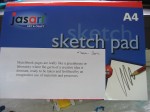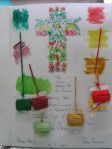Stage 1. Introduction and preparation
Sir Isaac Newton taught us that without light there is no colour and by share observation as darkness descends, colour diminishes. The primary hues of red, blue and yellow we are told cannot be created by mixing any other secondary or tertiary colours. When mixed together red and blue become violet;yellow and blue become green; and red and yellow become orange – as portrayed in the photo of a six (6) colour-colour wheel made from cotton patchwork fabrics:
The six-colour circle involves big jumps in hue.
 In order to reproduce the segments of the wheel I first started by drawing the design to scale on graph paper. The resulting shapes plus a 1/4″ seam became the templates for cutting out the pieces of fabric in the appropriate colours. Piecing the segments together and adding a black border created a visual concept of the six-colour wheel. I took some time in selecting the various colours in fabric as they were just not available off the shelf.
In order to reproduce the segments of the wheel I first started by drawing the design to scale on graph paper. The resulting shapes plus a 1/4″ seam became the templates for cutting out the pieces of fabric in the appropriate colours. Piecing the segments together and adding a black border created a visual concept of the six-colour wheel. I took some time in selecting the various colours in fabric as they were just not available off the shelf.
Mixing the primary colours in Gou ache paint was not as simple as it sounded and ended up looking messy. 110gsm paper is not strong enough for working on both the front and its back side. Vivid black markers are to be avoided as the ink penetrates poorer quality of paper and can disfigure work on the reverse side.
ache paint was not as simple as it sounded and ended up looking messy. 110gsm paper is not strong enough for working on both the front and its back side. Vivid black markers are to be avoided as the ink penetrates poorer quality of paper and can disfigure work on the reverse side.
To get nearer to a smoother transition I tried mixing colours next to each other to get an in between colour.

The colour wheel is the basic tool for combining colours.
The most common version is a wheel of twelve colours again reproduced here in visual form from cotton patchwork fabric. Getting the sewing machine out at least means that one’s handiwork can be admired. The black border accentuates the twelve colours but if the centre piece had been white it could have demonstrated the principle that when three primaries are combined, white light is seen because all colour is reflected.

Trying to mix colours together was less successful than I imagined it would be. The intention was to mix yellow red and blue and also green red and blue to see what colour would emerge as they overlapped. I assumed that where the three colours overlapped that I would end up with a colour akin to black or white. I need to rethink this experiment as although the paints were wet they did not in fact mix as well as if I had worked them together on a palette. At least I tried and had good intentions. I think I was more impressed with the curious surprises and the happy accidents than the frustration of the outcomes.
So that I had a record of the principles of colour mixing I photo copied notes on basic colour mixing schemes for further reference and pasted them in my sketchbook.

and just in case I need them later on I have purchased two aids/tools to help me select colours for perfect combinations every time and guide me in mixing colours:

I used a commercial set of water coloured paints under the name of “Maries’ which didn’t really mean anything at this stage. I surmise that I will become more particular once I have a better appreciation of the market and what paints and brushes are preferred by practicing artists. I will start to become more proficient in using and recording weight, volume and unit measures when mixing paints so that when I decide on a reproducing a particular colour I can go back and be sure of getting the same results as was the first mixture. Working with mixing tools such as tooth picks, cotton buds and ice cream sticks was not accurate enough to replicate special colours because I could not control the outcome.
It would appear that the outcomes are determined by my mind’s eye and the pleasure I derive from seeing an image or colour visually rather than an exact reproduction from a photo, image or object. Compare Rothko’s dense layering of paint to Seurat’s brush strokes and there are major differences – I know which paintings I prefer but reading the art historians revues and the different opinions will also become obvious as do the artists narratives of the works they present for galleries or exhibitions.
As for looking up the paintings by the French Impressionists and not having the benefit of seeing them in the raw but on a computer screen , it is not possible to see the brush markings whether they be dots as in pointillism or brush strokes as in a Monet. Will have to look more closely for English and French originals in an art gallery, but not possibly in New Zealand unless they are originals by New Zealand artists. Looking up such aspects as spatial illusions does not help that much unless one is willing to spend time studying the language and physics of textile and fine arts.
Any one colour be it primary, secondary or tertiary is not of the same hue family but can be of the same ‘value’ in terms of its shade be it light, dark or in between. Any colour can be of the same degree of saturation, be it shiny or dull. For example a green can have the same value or saturation as an orange.

Take a colour photo for example and copy it in black and white on a photo copier and immediately one can see the different values of the colours in a grey scale.

I agree that the eye does the mixing and interpretation of colours in a painting and that comes down to personal preference, hence the saying that beauty is in the eye of the beholder, not what you think is there but what your eye tells you is there. ‘Of the three ways to describe a colour, value is the most important because it is the first characteristic of a design that can be seen from any distance, and it remains important even at close range’. (Menz.2004)








































 In order to reproduce the segments of the wheel I first started by drawing the design to scale on graph paper. The resulting shapes plus a 1/4″ seam became the templates for cutting out the pieces of fabric in the appropriate colours. Piecing the segments together and adding a black border created a visual concept of the six-colour wheel. I took some time in selecting the various colours in fabric as they were just not available off the shelf.
In order to reproduce the segments of the wheel I first started by drawing the design to scale on graph paper. The resulting shapes plus a 1/4″ seam became the templates for cutting out the pieces of fabric in the appropriate colours. Piecing the segments together and adding a black border created a visual concept of the six-colour wheel. I took some time in selecting the various colours in fabric as they were just not available off the shelf.










You must be logged in to post a comment.